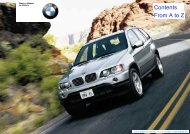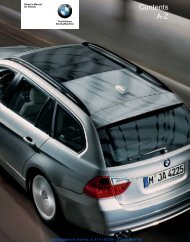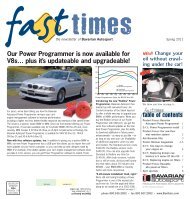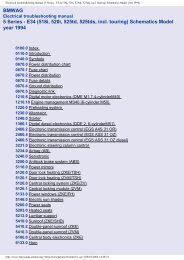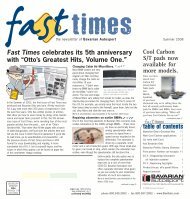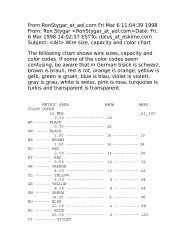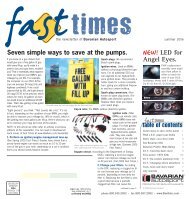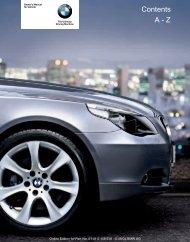Online Edition for Part no. 01 41 2 604 027 - © 03/10 BMW AG
Online Edition for Part no. 01 41 2 604 027 - © 03/10 BMW AG
Online Edition for Part no. 01 41 2 604 027 - © 03/10 BMW AG
You also want an ePaper? Increase the reach of your titles
YUMPU automatically turns print PDFs into web optimized ePapers that Google loves.
If you have deactivated DSC, it will be activated<br />
automatically.<br />
When driving with a damaged tire:<br />
1. Avoid sudden braking and steering maneuvers.<br />
2. Do <strong>no</strong>t exceed a speed of 50 mph/80 km/h.<br />
If the defective tire continues to lose pressure,<br />
its position will be indicated to you on<br />
the Control Display.<br />
3. At the next opportunity, check the air pressure<br />
in all four tires.<br />
If the tire inflation pressure in all four<br />
tires is correct, the Flat Tire Monitor<br />
may <strong>no</strong>t have been initialized. The system<br />
must then be initialized.<<br />
Possible driving distance with complete loss of<br />
tire inflation pressure.<br />
> With a light load:<br />
1 to 2 persons without luggage:<br />
Approx. 155 miles/250 km<br />
> With a medium load:<br />
2 persons, cargo area full, or<br />
4 persons without luggage:<br />
Approx. 95 miles/150 km<br />
> With a full load:<br />
4 or more persons, cargo area full:<br />
Approx. 30 miles/50 km<br />
Drive cautiously and do <strong>no</strong>t exceed<br />
speeds of 50 mph/80 km/h or else you<br />
run the risk of causing an accident.<br />
A loss of tire inflation pressure results in a<br />
change in the handling characteristics, e.g.<br />
reduced lane stability during braking, a longer<br />
braking distance and altered self-steering properties.<<br />
Vibrations or loud <strong>no</strong>ises while driving can<br />
indicate complete failure of the tire.<br />
Reduce your speed and stop; otherwise, pieces<br />
of the tire could come loose and cause an accident.<br />
Do <strong>no</strong>t continue driving, and contact your<br />
<strong>BMW</strong> Sports Activity Vehicle Center.<<br />
Tire Pressure Monitor TPM*<br />
The concept<br />
Monitoring of the tire inflation pressure in the<br />
four mounted tires. The system reports when<br />
the tire inflation pressure has dropped considerably<br />
in one or several tires.<br />
Function requirements<br />
The system must have been reset while the<br />
inflation pressure was correct; otherwise, reliable<br />
signaling of a flat tire is <strong>no</strong>t ensured.<br />
Always use wheels with TPM electronics to<br />
ensure that the system will operate properly.<br />
Reset the system again after each correction<br />
of the tire inflation pressure and after<br />
every tire or wheel change.<<br />
System limits<br />
Sudden serious tire damage caused by<br />
external influences can<strong>no</strong>t be indicated in<br />
advance.<<br />
The system does <strong>no</strong>t operate correctly if it has<br />
<strong>no</strong>t been reset. For example, a flat tire may be<br />
indicated despite correct tire inflation pressures.<br />
The system is inactive and can<strong>no</strong>t indicate a flat<br />
tire:<br />
> If a wheel without TPM electronics is<br />
mounted, e.g. a compact wheel*<br />
> If the TPM is disturbed by other systems or<br />
devices with the same radio frequency<br />
Status display<br />
The current status of the Tire Pressure Monitor<br />
TPM can be displayed on the Control Display,<br />
e.g. whether or <strong>no</strong>t the TPM is active.<br />
1. "Vehicle Info"<br />
2. "Vehicle status"<br />
1<strong>01</strong><br />
Reference Mobility<br />
Communications Entertainment Navigation Driving tips Controls<br />
At a glance



